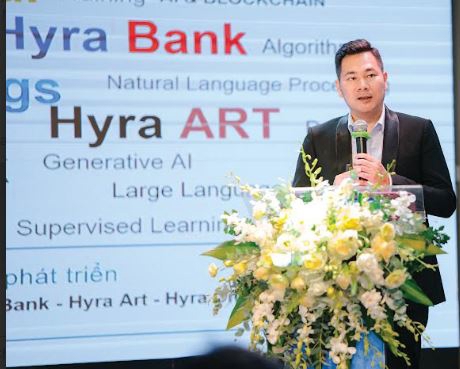Harnessing idle computing power
Mr. Tran Nam Chung, Founder and CEO of Hyra Holdings, tells Vietnam Economic Times / VnEconomy’s Hoang An and Bao Binh about its “decentralized edge computing shared infrastructure” model, which has the potential to open up a breakthrough for the AI industry.

What competitive advantages does the “decentralized edge computing shared infrastructure” model have over traditional data centers?
To better understand this, let’s first look at the historical context of data storage and processing. Data centers first began to emerge about 20-30 years ago. At the time, large corporations partnered with local companies to build mini data centers, bringing storage and processing equipment closer to users and improving internet access speeds; something we experience today.
We are now in the second stage: cloud computing. Data is stored partly on personal devices like phones, laptops, and iPads, with the remainder stored in the cloud, where users can purchase additional storage. However, the trend is shifting towards edge computing, where data is distributed and processed using edge devices.
Traditional data centers face several challenges, such as high costs and long construction times. To build a large data center, companies need permits, land, and significant investment in infrastructure. In Vietnam, obtaining permits and constructing facilities can take 20-24 months, with total investment costs reaching hundreds of millions or even billions of dollars for equipment imports and operations. Additionally, the lifecycle of equipment is short, typically around four years, resulting in high depreciation costs.
Can you elaborate on how the decentralized edge computing shared infrastructure model operates, especially given the growing demand for AI applications?
Taking advantage of the edge computing trend and the rapid development of the AI industry, which is facing a severe shortage of hardware infrastructure, this new shared economy model does not require investment in data centers, land, or hardware equipment. Instead, it leverages surplus computing power from edge devices such as smartphones, PCs, laptops, smart TVs, and even, in the future, electric vehicles. The total estimated computing capacity from edge devices globally is around 12 billion hours of available computing power.
Due to not bearing enormous investment costs like traditional data centers, the model will significantly reduce capital expenses. It can be compared to platforms like Grab or Airbnb in the transportation and tourism sectors: they don’t own assets (vehicles or real estate) but still offer efficient services. As a result, Hyra’s AI infrastructure service costs only 40 per cent of the average price of the “big players” in the market, helping individual and business clients save up to 60 per cent in infrastructure costs.
What are the biggest challenges for the decentralized edge computing shared infrastructure model?
While the model has many advantages, it also comes with significant challenges in deployment and scaling.
The first challenge is technical. Moving AI models and datasets to edge devices like smartphones is complex. For instance, Google’s machine learning framework released in 2016 was designed only for PCs and laptops. Hyra had to develop its own solution to break down datasets and AI models and push them to edge devices, utilizing the processing power of smartphone chips.
Currently, while several dozen companies globally are developing decentralized infrastructure, most only use the computing power of GPUs and CPUs in PCs and laptops. Hyra is one of the few pioneers utilizing NPUs on smartphones, which creates a technological advantage but also presents complex technical hurdles.
The second challenge is stability and user motivation. For distributed infrastructure to work efficiently, edge devices must be online 24/7, providing computing power. However, this can reduce device lifespan, drain battery life, and consume internet bandwidth. Hyra must ensure that users (who own the edge devices) are financially incentivized to continue leasing their computing power. This is similar to Grab’s model, where drivers (vehicle owners) need consistent work to stay engaged with the platform. In Hyra’s case, businesses and individuals requiring AI infrastructure are the “customers”. If demand is not sufficiently large or stable, edge device users may stop participating, just as Grab drivers may leave if there aren’t enough ride requests.
The third challenge is competition. Once Hyra’s business model proves successful, larger players with more resources might copy the idea. However, Hyra has the advantage of being a first mover. Competitors would need about 18-24 months to develop a similar solution, giving Hyra the chance to establish itself as a market leader, much like Uber did in the transportation sector.
You mentioned that the decentralized edge computing model is similar to Grab and Uber. In the early days, both had to compete fiercely, offering many free rides. Many said it was a “money-burning game”. How does Hyra approach this?
Indeed, Hyra’s shared economy model shares similarities with Grab and Uber, especially in how we initially acquire customers. Just as Grab used free rides to get people to adopt the habit of using the platform, Hyra also uses incentives to attract users and customers. However, unlike Grab’s aggressive “money-burning” strategy, where they paid drivers directly and offered free or discounted rides, Hyra takes a different approach to reduce financial pressure.
Instead of paying edge device owners with cash right away, we reward them with native tokens. These tokens can be liquidated when Hyra is listed on an exchange. This reduces the financial burden in the early stages, though we still invest in marketing to build the brand. The costs, however, are much lower than traditional platforms or Grab’s strategy.
For customers using AI infrastructure services, Hyra offers free credits (from $20,000 to $200,000) to let them try the service. After using up the credits, customers can assess the service’s feasibility and stability. The trial-to-paid transition usually takes 3-6 months. After that, customers pay fully in cash, providing Hyra with stable revenue. For edge device users, we continue to reward them with tokens to optimize costs.
Compared to ride-sharing platforms like Gojek, which struggled in Vietnam due to fierce competition and a “money-burning” strategy, Hyra holds and advantage with its token reward model and lower operational costs. We optimize costs and use the shared economy model to reduce the need for heavy infrastructure investments, like traditional data centers. This allows us to maintain a competitive strategy without excessive spending.
How is the trend of decentralized edge computing infrastructure sharing evolving globally, and how will Hyra compete with major players entering the market?
Globally, this trend is still in its early stages, gaining traction only in recent years. Decentralized physical infrastructure networks are being applied across many industries, but in the edge computing space there are currently about 20 companies worldwide involved.
However, most of these companies only utilize computing power from PCs and laptops (i.e., from GPUs and CPUs), whereas Hyra is the first and only company in the world to harness computing power from NPU chips in smartphones. This gives it a unique competitive advantage, especially with the growing demand for AI infrastructure.
Do you have any estimates or figures on how much electricity, water, and technological resources the decentralized edge computing model helps save?
Clearly, compared to traditional data centers, Hyra’s decentralized model significantly reduces environmental impact. Centralized data centers consume enormous amounts of electricity and water for cooling systems, in addition to the investment costs in GPUs and infrastructure. On the other hand, Hyra uses advanced techniques to break down complex AI models and datasets and push them to edge devices like smartphones or laptops.
These devices are already available, consuming much less bandwidth and electricity compared to centralized systems. For example, if you imagine a heavy workload of 100 tons being processed by a “large truck” (data center), Hyra breaks this task into smaller pieces and assigns them to “simple vehicles” (edge devices), optimizing cost and resources.
Though there are no specific reports on the percentage reduction in energy consumption, this model clearly offers superior environmental and cost efficiency compared to traditional data centers.
In such a relatively new field, how does Hyra convince customers to use its infrastructure services? How will data security be addressed?
For customers using Hyra’s AI infrastructure services, the biggest challenge is the trustworthiness of a young brand. Hyra is only in its fourth year of operations, so customers may have doubts about the platform’s reliability compared to the major players. However, the significant cost advantage (saving at least 60 per cent compared to the market) is a strong motivator for them to try the service. Typically, customers do not switch their entire system immediately; they test individual modules to evaluate stability and effectiveness before scaling up.
Regarding data security, we address this with technology, ensuring that only customers have access to and can intervene in their data and models. Neither Hyra nor any third parties can access or interfere, protecting the client’s intellectual property.
In fact, we only leverage the computing power of the edge devices’ hardware and do not collect or process personal user data.
After the initial free phase, what is the expected pricing framework for the system?
Hyra follows a pricing strategy similar to Grab’s model. Initially, we offer services at an extremely competitive price, approximately 40 per cent of the average rate of traditional providers. The goal is to gain a competitive edge and quickly attract users to build the brand.
Once the platform stabilizes, users are familiar with the service, and operational costs are optimized, we will gradually increase prices. The plan is to raise prices by around 5 per cent each year until reaching a maximum of about 70 per cent of market rates. This pricing ensures businesses still save at least 30 per cent compared to traditional providers.







